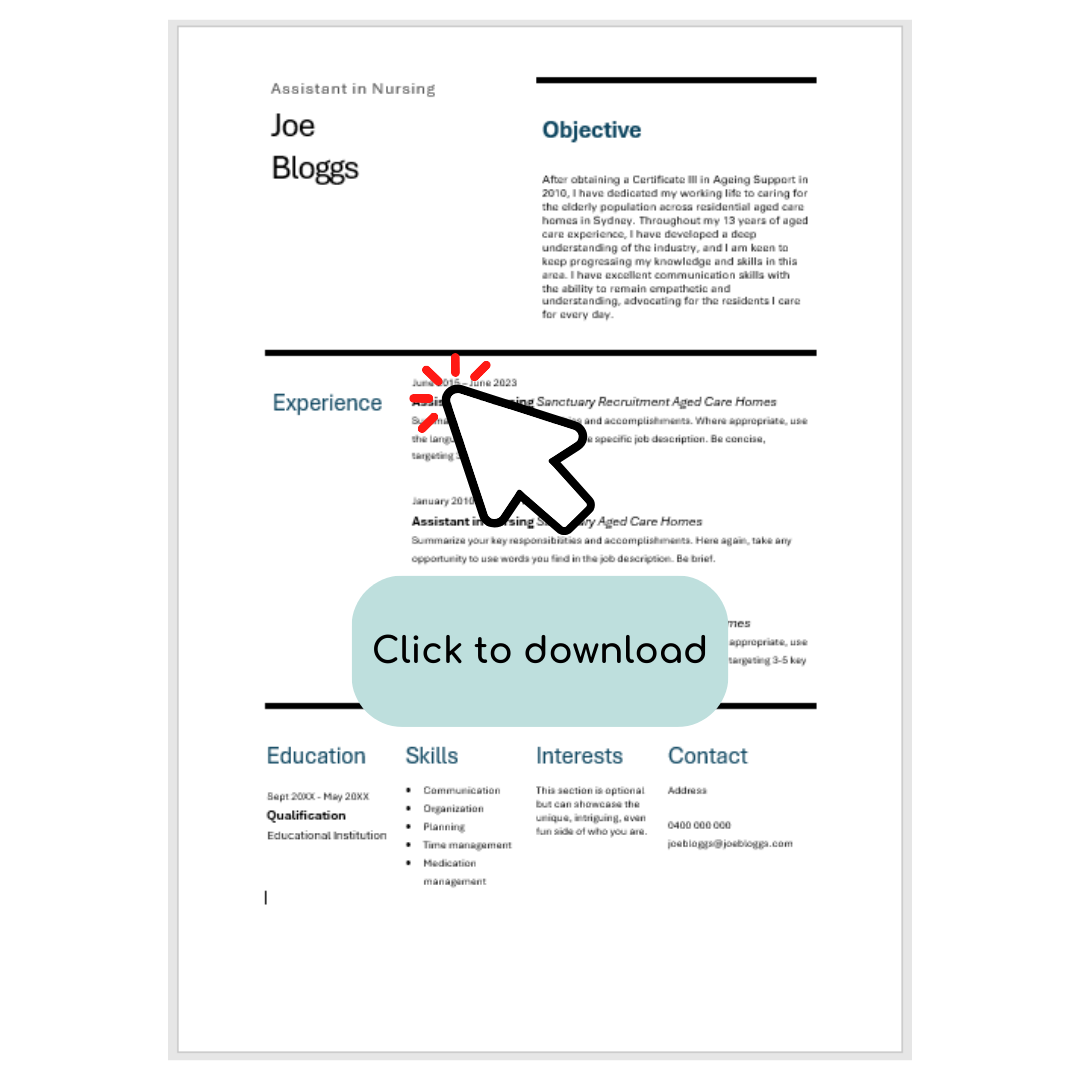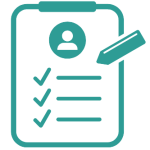
Create your Aged Care Resume with Sample
First published: January 2024
The aged care industry is constantly changing and progressing, with new opportunities being planned in the aged care reform roadmap. When looking to land your dream job, standing out from the competition can be done through a high-quality aged care resume. Showing off your invaluable experience and aged care qualifications is essential. This post details how to perfect your aged care resume with examples. Regardless of whether you are looking to transition into the industry, seek a promotion, or are just entering the workforce, this resume builder can be adapted for multiple applications.
Resume template for aged care workers
Aged care resume example
An aged care resume should be easy to read but thorough. Condensing your education, skills, and experience down into a one-to-two-page document isn’t the easiest task. We’ve put together an aged care resume example that does just that:
Joe Bloggs
Sydney, NSW, 2000
joebloggs@sanctuaryrecruitment.com
0400000000
A caring and passionate aged care worker experienced in providing holistic care to aged care residents.
After obtaining a Certificate III in Ageing Support in 2010, I have dedicated my working life to caring for the elderly population across residential aged care homes in Sydney. Throughout my 13 years of aged care experience, I have developed a deep understanding of the industry, and I am keen to keep progressing my knowledge and skills in this area. I have excellent communication skills with the ability to remain empathetic and understanding, advocating for the residents I care for every day. I am seeking a new assistant in nursing role as I have recently relocated to the area, and I am available to work on a rotating roster.
Education
Qualifications obtained
Certificate III in Ageing Support
TAFE NSW 2009 – 2010
Work Experience
Assistant in Nursing
Sanctuary Aged Care Recruitment Homes 2015 – 2023
I was employed in the position of assistant in nursing and my day-to-day duties included personal care, ADLs, taking instruction from registered nurses, and helping complete care plans and documentation. I am medication competent, so I also administer medications when appropriate. I have experience working in high & low-care, and dementia wards, and I can remain professional whilst displaying empathy and support. I have developed an excellent rapport with my residents.
Assistant in Nursing
Sanctuary Aged Care Homes 2010 – 2015
I joined Sanctuary Aged Care immediately after qualifying and put my education into practice through ADLs, personal care, and assisting with care plans. I was present through the accreditation process and worked with my colleagues and management team to ensure the home received accreditation status. Nearer the end of my time there, I was an AIN team leader. I mastered the new note taking and recording system we adopted and developed the ability to communicate with residents from all backgrounds.
Skills
Throughout my education and career, I have acquired the following skills:
- Communicating with residents with culturally diverse backgrounds
- Nonverbal communication
- Empathy and patient advocacy
- Manual handling
- Patience
- Multi-tasking and working under pressure
- Organisation
References available upon request.
You can adapt the layout as you wish, as long as it is written clearly, looks clean and ends at the bottom of the page. Follow this structure and your aged care resume will be sure to wow any employer!
Writing a strong aged care resume
Example of a great aged care resume
There are blanket rules when it comes to building an aged care resume. Make sure you include your:
- Full name
- Contact details (email address and phone number are ideal)
- Location (suburb, postcode, and state are sufficient)
You can also add in your current job title underneath if you wish. These details should be included at the top and can be structured as you see fit, as long as they are clear and easy to read.
Do not feel obliged to include your gender or date of birth.
Sell your experience as an aged care worker
Next, summarise your experience, aged care qualifications, and personality in a few sentences to introduce yourself. This can be a tricky task; getting all this condensed into a short paragraph is not easy. We would recommend:
- Highlighting your qualifications and how you have actively put these into practice. Simply listing your qualifications won’t be as effective.
- Mentioning skills and knowledge you have developed because of your current work or voluntary experience. This will show you’re proactive in personal development and eager to learn.
- Stating what you are looking for. Not necessarily salary wise, but you can talk about what you’re looking to get out of a new aged care role. Think about how this new position will benefit your career journey, as well as to the home you’re applying for.
Your aged care qualifications
This is the necessary part of your aged care resume. It must be included to show you have the education requirements for the role you’re applying for.
List the aged care qualification name, the institution, and the years qualified.
You can lay out qualifications in your aged care resume using the following method (always from most recent to oldest):
(Aged care qualification earned)
(Institution acquired from) (Years obtained)
You can switch the layout if you want to and have all the details listed on one side:
(Aged care qualification earned)
(Institution acquired from)
(Years obtained)
As long as the layout you choose displays uniformity, you can change the alignment as you wish.
Aged care work history
This is potentially the most vital part of your aged care resume. Whether your experience is paid or voluntary, this is the perfect opportunity to highlight your skills and knowledge. It can also help you to stand out from your competitors.
When you’re creating this section, detail your most recent experience first and oldest last. You can use the layout above but change it to include your title, place of work, when you worked there. If you’re still in this position, use ‘Current’ as your end date.
You can also split your experience into paid and voluntary roles if you’ve done plenty of voluntary work or don’t have much paid experience. Harness the job advertisement that you are applying for. If the advert hones in on a particular skill set or knowledge area, use this in your application. The experience you have should display the knowledge and the skills that the job description is looking for. Focus on the advertisement’s wants and needs and always back up your claims with examples.
Transferable aged care skills
This is optional but can sometimes be a key part of an aged care resume. You may want to add a section that lists the skills that you’ve developed through your study or work experience. If you’re going to include this, make sure it is relevant otherwise it will seem that you’re short of things to say about yourself. You can bullet point these, or depending on the layout you have chosen, you can list them at the side of your resume (see example below).
Heading: ‘Skills acquired/key skills/additional skills‘ (you can choose which one you pick):
- Written communication
- Multitasking
- Organisation and planning
- Medication management – if you want to, you can include a short example or elaborate on each point to back up your claim
Aged care references
References are non-negotiable. You need to make sure you have at least two clinical references (if possible) with their permission ready to go. However, you don’t necessarily need to have these on your aged care resume.
Adding in ‘References available upon request’ shows you’re able to fulfill the requirement whilst keeping your referee’s personal details confidential.
Extra tips for building an excellent aged care resume
Your aged care resume should be simple to edit so that you can easily tailor it to the job you’re applying for. The foundation can be the same, but having this flexibility can increase the likelihood of receiving those job offers. Also keep these tips in mind when writing your resume and applying for new jobs:
- Remember what you’re applying for. Your resume shouldn’t be stagnant. Read the job advertisement properly and
emphasise the skills and knowledge that the employer is looking for. - Sell yourself! Your resume is about you and what you bring to the table. Don’t be shy in advocating for yourself and highlight what you are great at.
- Be honest. As tempting as it is to fabricate some points on your resume, this will ultimately hinder your application. If you don’t have the amount of experience they’re asking for, don’t say that you do. Instead, focus on what you do know and emphasise why you’re the ideal candidate, experience or not.
- Don’t be afraid to apply for jobs that you don’t meet the exact requirements for. You will need the relevant aged care qualifications, but lacking experience in a certain area shouldn’t necessarily be a reason not to apply. Many employers will consider your application if you display the right attitude, enthusiasm, and willingness to learn.
- Use the correct formatting. Choose a clear font, a good size text (11 works well), bolding for headers and bullet points for structure. Having a resume that looks good gives the employer all the more motivation to read it
- Proofread your resume. A resume with mistakes doesn’t look professional and may be neglected, no matter how much of a strong candidate you are.
Resume complete? Prepare for your aged care interview and secure your dream role!
Writing an aged care resume and the job application process can be daunting, but we hope this article will help you when you’re next looking for a role. If you’re in the market for a new opportunity, would like to see what we roles we have available, or for a confidential career discussion, please call us on 02 8549 8101 or for a free resume assessment, submit your resume below:





